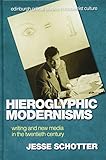Hieroglyphic Modernisms : Writing and New Media in the Twentieth Century / Jesse Schotter.
Material type: TextSeries: Edinburgh Critical Studies in Modernist Culture : ECCSMCPublisher: Edinburgh : Edinburgh University Press, [2022]Copyright date: ©2017Description: 1 online resource (272 p.) : 9 B/W illustrationsContent type:
TextSeries: Edinburgh Critical Studies in Modernist Culture : ECCSMCPublisher: Edinburgh : Edinburgh University Press, [2022]Copyright date: ©2017Description: 1 online resource (272 p.) : 9 B/W illustrationsContent type: - 9781474424776
- 9781474424783
- 493.111 23
- online - DeGruyter
| Item type | Current library | Call number | URL | Status | Notes | Barcode | |
|---|---|---|---|---|---|---|---|
 eBook
eBook
|
Biblioteca "Angelicum" Pont. Univ. S.Tommaso d'Aquino Nuvola online | online - DeGruyter (Browse shelf(Opens below)) | Online access | Not for loan (Accesso limitato) | Accesso per gli utenti autorizzati / Access for authorized users | (dgr)9781474424783 |
Frontmatter -- CONTENTS -- List of Illustrations -- Acknowledgements -- Series Editors’ Preface -- Introduction: A Hieroglyphic Civilisation -- Part I -- 1 Misreading Egypt -- 2 The Hieroglyphics of Character -- 3 Sound Enclosures -- Part II -- 4 The ‘Essence’ of Egypt -- 5 Solving the Problem of Babel -- 6 Matrices and Metaverses -- Coda: The Rosetta Stone -- Bibliography -- Index
restricted access online access with authorization star
http://purl.org/coar/access_right/c_16ec
Explores hieroglyphs as a metaphor for the relationship between new media and writing in British modernismIn the British Museum, one object attracts more tourists than any other: the Rosetta Stone. The decipherment of the Stone by Jean-François Champollion and the discovery of King Tutankhamun’s tomb in 1922 contributed to creating a worldwide vogue for all things Egyptian. This fascination was shared by early-twentieth-century authors who invoked Egyptian writing to paint a more complicated picture of European interest in non-Western languages. Hieroglyphs can be found everywhere in modernist novels and in discussions of silent film, appearing at moments when writers and theorists seek to understand the similarities or differences between writing and new recording technologies. Hieroglyphic Modernisms explores this conjunction of hieroglyphs and modernist fiction and film, revealing how the challenge of new media spurred a fertile interplay among practitioners of old and new media forms. Showing how novelists and film theorists in the modernist period defined their respective media in relation to each other, the book shifts the focus in modernism from China, poetry, and the avant-garde to Egypt, narrative, and film. Key Features:Argues for the connections among discourses about film, phonography, digital media, and literature in the twentieth century through the recurrent invocations of hieroglyphsShows how novelists and film theorists in the modernist period defined their respective media in relation to each otherShifts the focus in accounts of visual languages in modernism from China, poetry, and the avant-garde to Egypt, narrative, and filmEstablishes a dialogue between Egyptian writers of the 1920s and 30s and canonical British modernists
Mode of access: Internet via World Wide Web.
In English.
Description based on online resource; title from PDF title page (publisher's Web site, viewed 29. Jun 2022)


